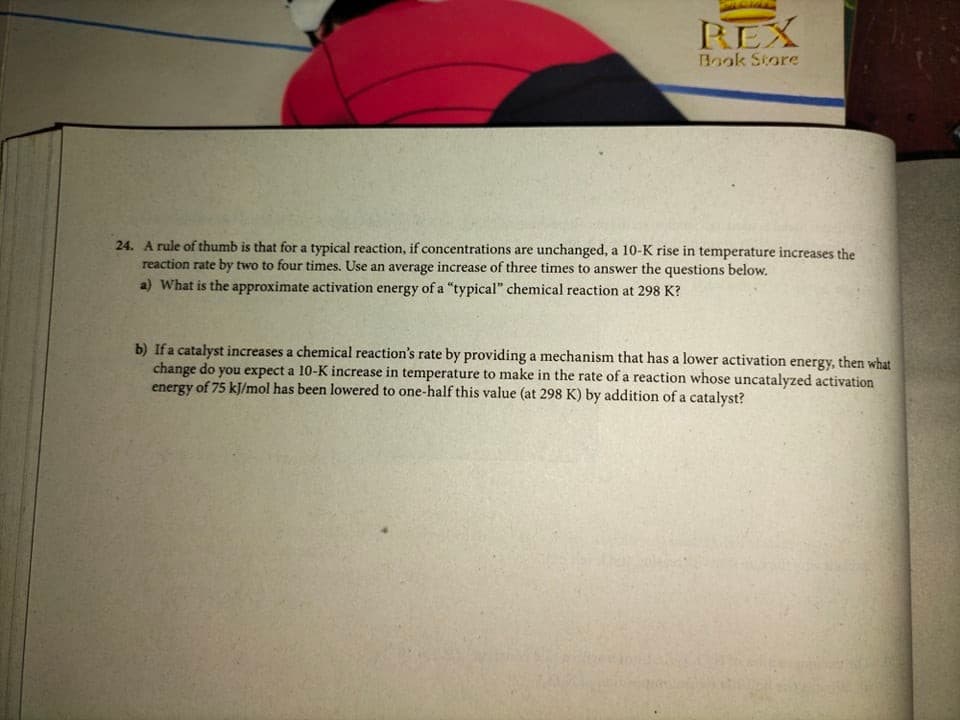reaction, if concentrations are unchanged, a 10-K rise Jse an average increase of three times to answer the qu tion energy of a "typical" chemical reaction at 298 K?
reaction, if concentrations are unchanged, a 10-K rise Jse an average increase of three times to answer the qu tion energy of a "typical" chemical reaction at 298 K?
Chemistry: The Molecular Science
5th Edition
ISBN:9781285199047
Author:John W. Moore, Conrad L. Stanitski
Publisher:John W. Moore, Conrad L. Stanitski
Chapter11: Chemical Kinetics: Rates Of Reactions
Section: Chapter Questions
Problem 11.ACP: (Section 11-5) A rule of thumb is that for a typical reaction, if concentrations are unchanged, a...
Related questions
Question

Transcribed Image Text:REX
Book Store
24. A rule of thumb is that for a typical reaction, if concentrations are unchanged, a 10-K rise in temperature increases the
reaction rate by two to four times. Use an average increase of three times to answer the questions below.
a) What is the approximate activation energy of a "typical" chemical reaction at 298 K?
b) If a catalyst increases a chemical reaction's rate by providing a mechanism that has a lower activation energy, then what
change do you expect a 10-K increase in temperature to make in the rate of a reaction whose uncatalyzed activation
energy of 75 kJ/mol has been lowered to one-half this value (at 298 K) by addition of a catalyst?
Expert Solution
This question has been solved!
Explore an expertly crafted, step-by-step solution for a thorough understanding of key concepts.
Step by step
Solved in 2 steps with 3 images

Knowledge Booster
Learn more about
Need a deep-dive on the concept behind this application? Look no further. Learn more about this topic, chemistry and related others by exploring similar questions and additional content below.Recommended textbooks for you

Chemistry: The Molecular Science
Chemistry
ISBN:
9781285199047
Author:
John W. Moore, Conrad L. Stanitski
Publisher:
Cengage Learning

Chemistry: Principles and Reactions
Chemistry
ISBN:
9781305079373
Author:
William L. Masterton, Cecile N. Hurley
Publisher:
Cengage Learning


Chemistry: The Molecular Science
Chemistry
ISBN:
9781285199047
Author:
John W. Moore, Conrad L. Stanitski
Publisher:
Cengage Learning

Chemistry: Principles and Reactions
Chemistry
ISBN:
9781305079373
Author:
William L. Masterton, Cecile N. Hurley
Publisher:
Cengage Learning


Chemistry
Chemistry
ISBN:
9781305957404
Author:
Steven S. Zumdahl, Susan A. Zumdahl, Donald J. DeCoste
Publisher:
Cengage Learning

Chemistry: An Atoms First Approach
Chemistry
ISBN:
9781305079243
Author:
Steven S. Zumdahl, Susan A. Zumdahl
Publisher:
Cengage Learning

Chemistry for Engineering Students
Chemistry
ISBN:
9781337398909
Author:
Lawrence S. Brown, Tom Holme
Publisher:
Cengage Learning